
Crispy, juicy, and full of umami flavor—siu yuk, or Chinese roast pork belly, is a dish that always impresses. Traditionally roasted in an oven or over open flames, this Cantonese favorite might seem intimidating to make at home. But here’s the good news: you can achieve crackling skin and tender meat right in your air fryer!
Whether you’re craving a savory snack, building a rice bowl, or looking for a show-stopping dish for guests, this air fryer version delivers all the flavor and crunch just like you’d get from a dim sum restaurant.

Why this recipe
I tested this recipe countless times trying out different methods, and I have incorporated all the key points in this recipe to create the ultimate puffy crackling pork skin and juicy meat.
- Air drying overnight is the key. In Cantonese restaurants, chefs would air dry the pork with a fan for a very long time to dry out the skin, which is the key to creating fully puffed skin. When I roasted the pork belly without this step, there were always some tough spots underneath the skin even if the surface was fully puffed.
- Marinating the meat creates a much juicier and more flavorful result. Since you’re already drying out the pork overnight, this is just an extra step that doesn’t take long but creates 2x the return.
- Air fry at a lower temperature and then at a higher one. I’ve tried roasting at high temperature to develop the crispy skin first, but I found that using a low temperature at first creates much better results. The slow roasting softens the pork skin and renders some fat, making it puff better at a higher temperature later.
- You should salt the pork skin for better crackling and seasoning. The salt helps to draw moisture out from the skin and season it at the same time. Using an appropriate amount of salt without over seasoning is the only way to get the best texture and flavor.

Air fryer siu yuk ingredients
How to shop for pork belly
If possible, shop for a square piece of pork belly that has an even thickness. If not available, the next best option is to buy a large rectangular piece that is as wide as possible.
Sometimes your only option might be thinly cut pork belly pieces that are about 1” (1.5 cm) thick. In this case, you can stack a few pieces together to make a larger rectangular piece and roast them the same way. I’ve tried that approach and it produced a very good result.
In my recipe, I used pork belly purchased from Chinatown. It is quite thick and has some ribs attached to the lean meat. So I trimmed off the bone part to give the pork belly an even thickness.
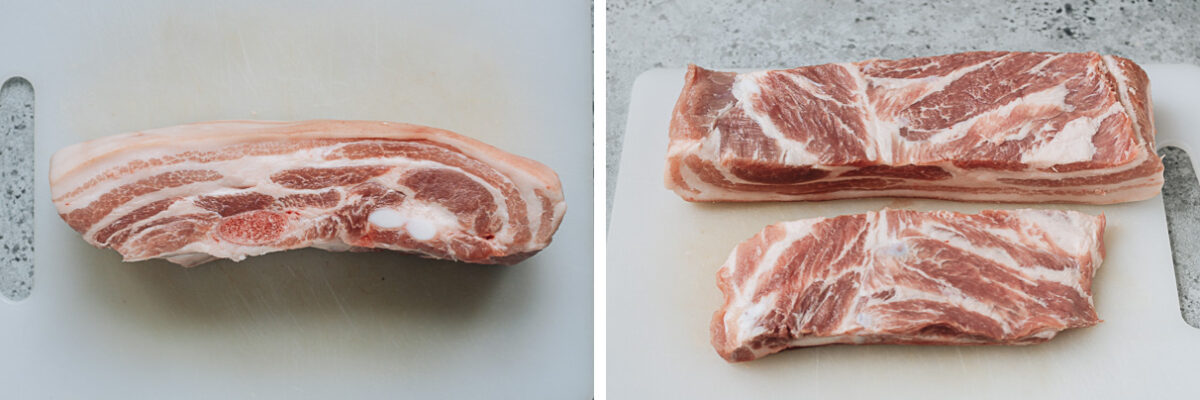
Marinating ingredients
The rest of the ingredients are quite common and you might have most of them in your pantry.
- Vinegar
- Sea salt and kosher salt
- Sugar
- Five spice
- White pepper
- Garlic powder
- Hoisin sauce
How to make air fryer siu yuk
There’s quite a bit of prep work that goes into air fryer siu yuk, but all of the steps are important for the best result.
- Prick the pork skin, then use hot water mixed with vinegar to scald the pork and render out some fat.
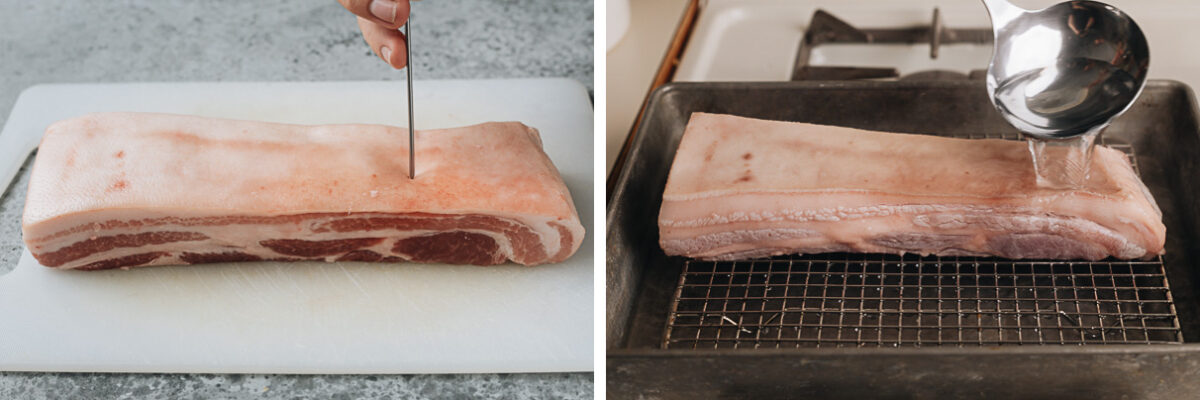
- Score the pork meat, brush it with hoisin sauce, then sprinkle evenly with the spice mix.

- Sprinkle kosher salt evenly over the skin, then air dry it in the fridge overnight (or even two nights if you want to prepare this dish in advance).
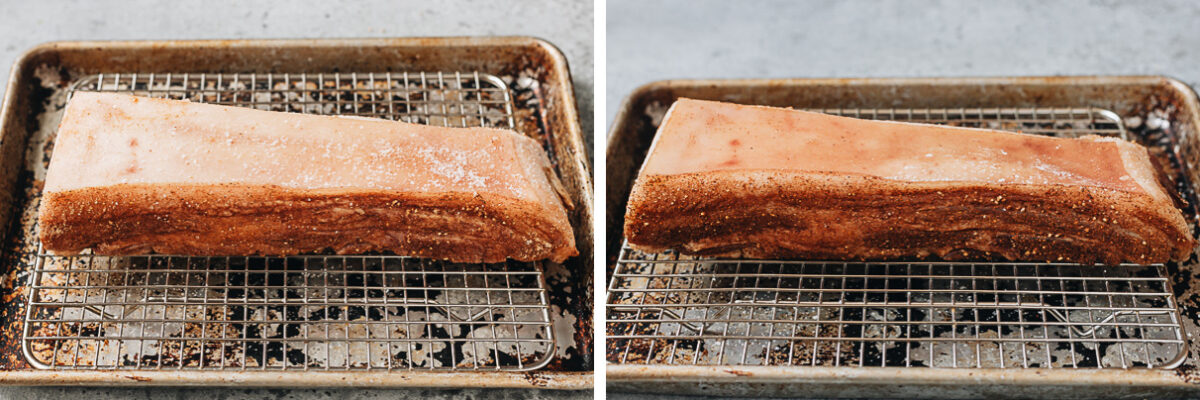
- Use foil to make an open box to wrap around the pork meat, exposing the skin on top. This step helps the pork to “stand” in the air fryer, and prevents the meat from overbrowning.
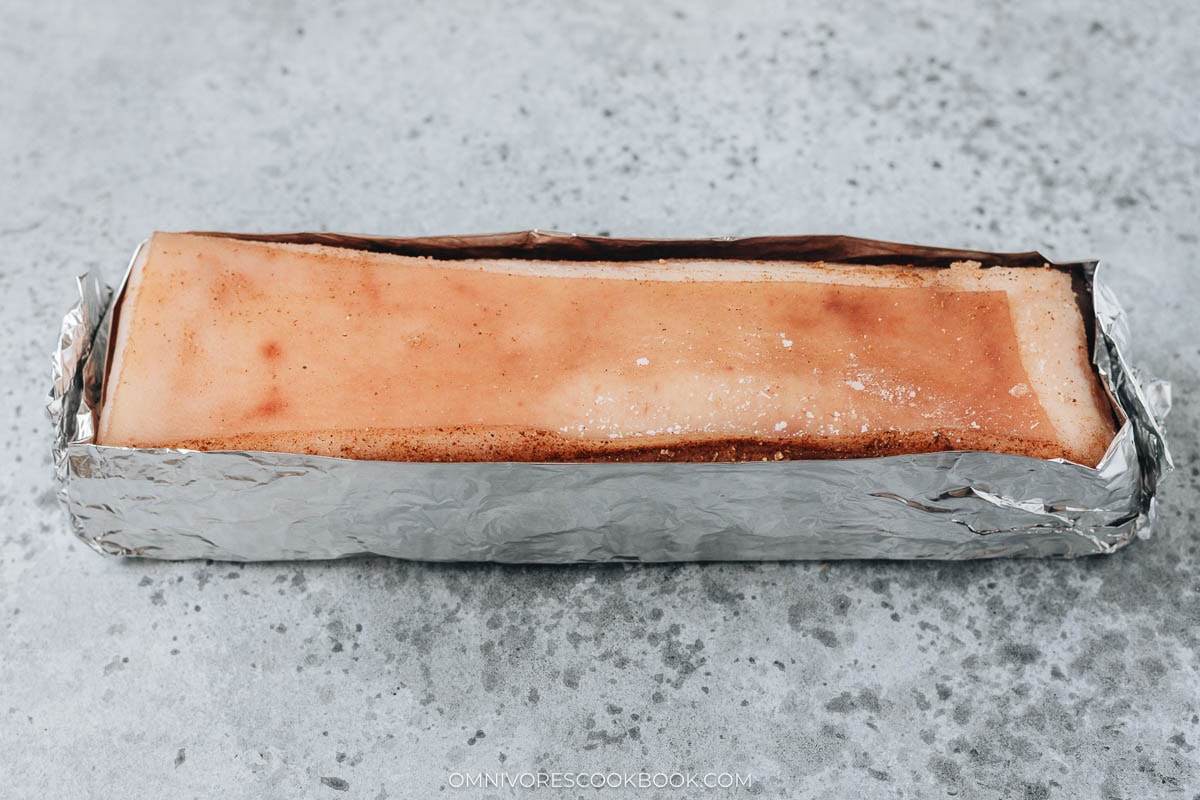
How to cook siu yuk in an air fryer
Once you have all the prep work done, you can proceed to the air frying process.
To air fry the pork, you will cook it at 250°F (120°C) for 30 minutes, then turn to a higher temperature to roast another 30 to 40 minutes.
The higher temperature roasting is a little tricky. For the best crispy texture, you want to roast the pork at a high temperature as long as you can. But since each air fryer model is different, you might need a little experimentation for the best result.
If you have a regular air fryer or a model that’s older, start at 400°F (200°C), and lower by 25°F at a time if the skin starts to turn dark brown too fast.
If you use a very powerful air fryer or a toaster oven type air fryer, you might need to start at 375°F (190°C), and further lower to 350°F (176°C) to finish up.
Stay close by during the roasting process. When the skin starts to burn, your nose will notice it first.
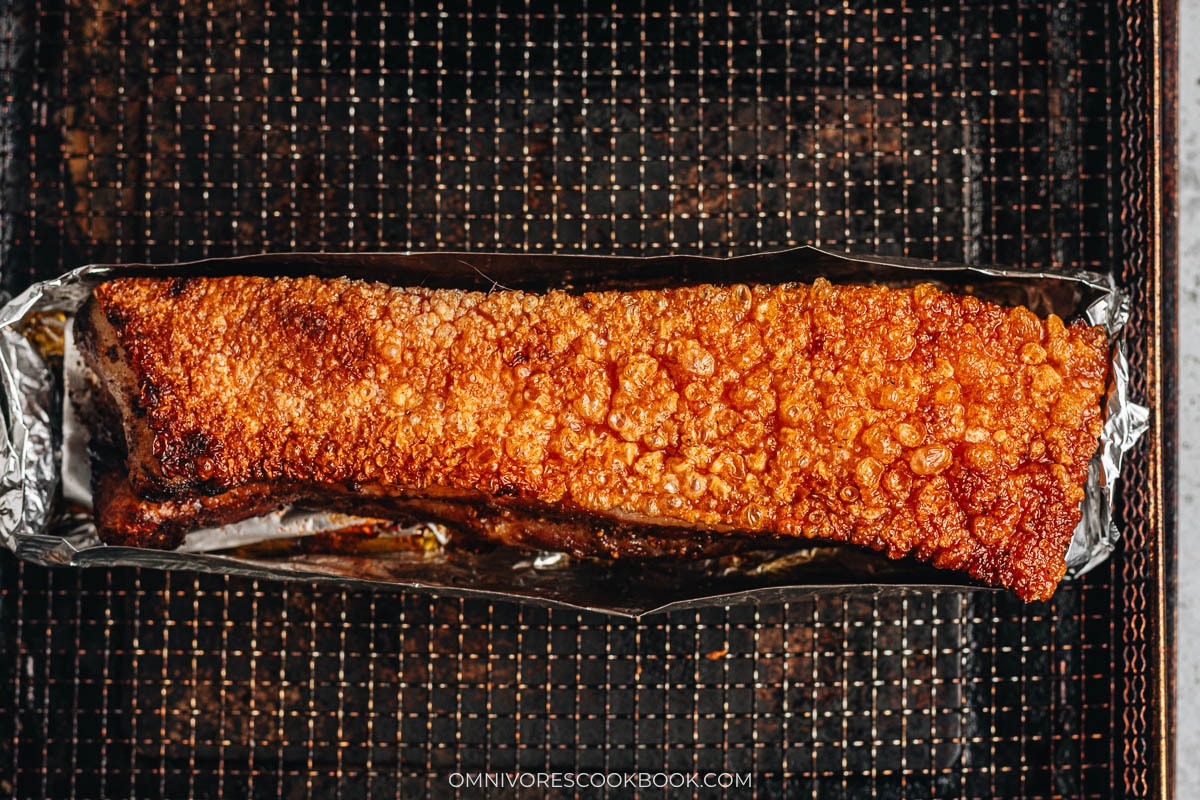
How Chinese restaurants do it
It’s very normal to have a little over browned spots on your air fryer siu yuk. Just so you know, Chinese restaurants usually roast the pork at a very high temperature and will end up with a lot of burned spots. The chef would scrape off the burned bits before serving. That’s why the siu yuk at your dim sum spot looks perfectly golden without any uneven spots.
Another thing to note is, the pork belly I used has dark meat on the bottom. Chinese restaurants usually trim off this layer, for a consistent result and a shorter siu yuk piece. I really like the taste of the dark meat so I kept it. And that’s why my siu yuk pieces look taller than those you’d see in a restaurant.
How to serve air fryer siu yuk
In dim sum restaurants, siu yuk is often served as an appetizer by itself, or along with Char Siu Pork, Cantonese Roast Duck, and Soy Sauce Chicken as a combo plate, or with any of those meats over rice or noodle soup as a main dish.
The restaurant version siu yuk is often quite salty, not served with a dipping sauce or a simple dollop of yellow mustard paste (the Asian type, in bright yellow color).
When making air fryer siu yuk at home, I prefer to use less salt to achieve a better flavor that’s more fragrant. Besides the mustard, I also like to use a slightly sweet sauce to balance out the salty taste. I found Chinese plum sauce and hoisin sauce work really well. If you prefer a savory taste, also try out my Ginger Scallion Sauce.
Air fryer siu yuk can be prepared in advance and it will stay crispy after it has cooled off, making it a perfect party food. You can either serve it as an appetizer or one of the main dishes with rice.
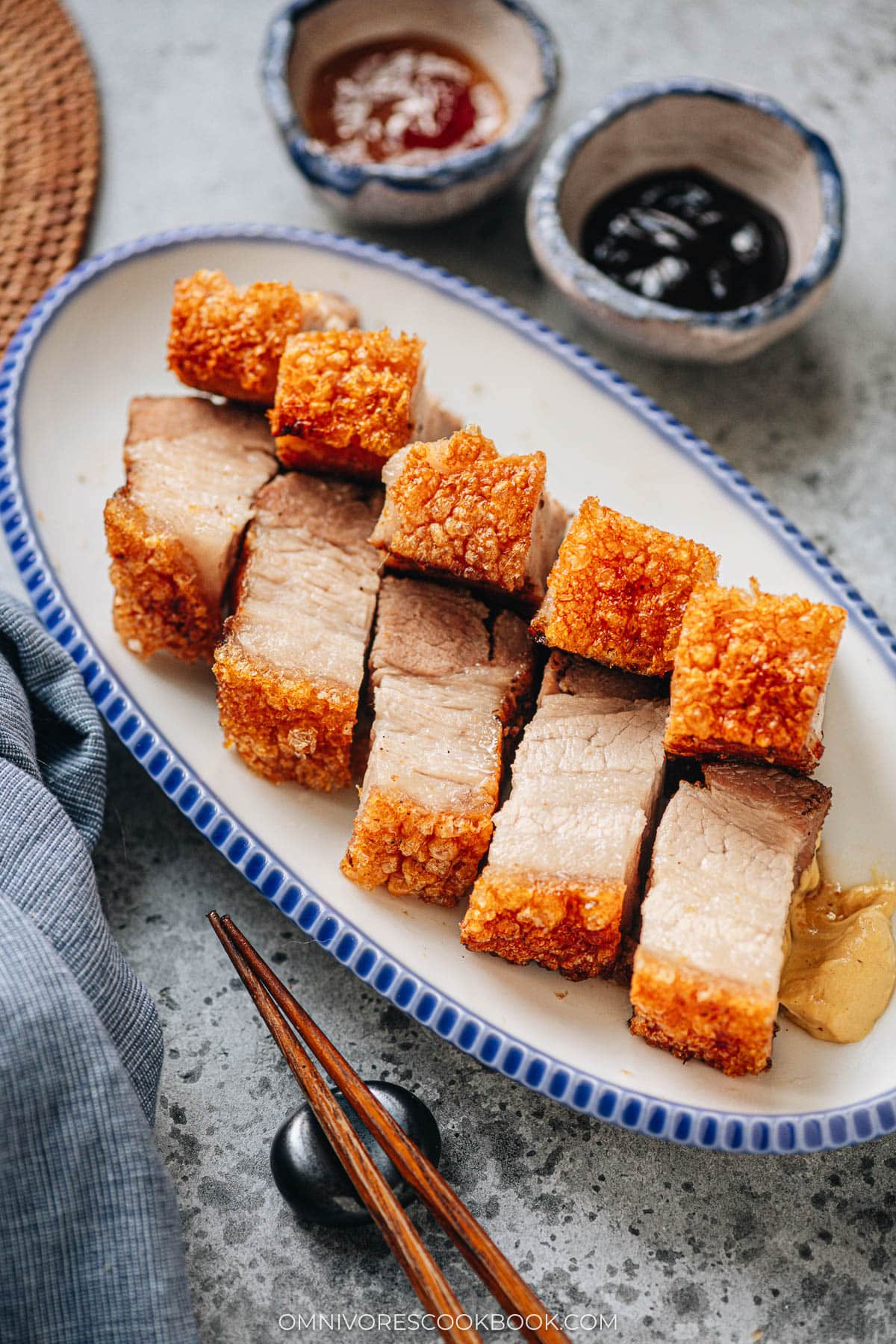
More Cantonese recipes
- Cheung Fun with Shrimp (鲜虾肠粉)
- Pickled Daikon with Carrot
- Salt and Pepper Chicken Wings (Oven Baked Version)
- Sesame Balls
- Longevity Noodles (Yi Mein, 伊面)
- Shrimp Toast
Chinese Cooking Made Easy
Are you new to this website? This free email series is a great place to start. I’ll walk you through a few of my most popular recipes and show you how and why they work. You’ll quickly start to cook better Chinese food in your own kitchen.
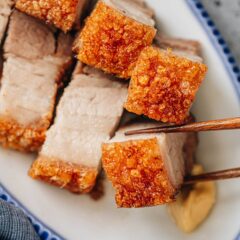
Air Fryer Siu Yuk (空气炸锅脆皮猪肉)
Ingredients
- 2 to 3 lbs pork belly (*Footnote 1)
- 2 tablespoons vinegar
- 2 teaspoons sea salt
- 1 teaspoon sugar
- 1 teaspoon five spice
- 1 teaspoon white pepper
- 1 teaspoon garlic powder
- 2 teaspoons hoisin sauce
- 1 teaspoon kosher salt (*Footnote 2)
Instructions
- Using a paring knife, fork or other small sharp object, thoroughly prick the entirety of the skin. This step helps the fat render much better, resulting in crispier skin.
- Add 4 cups of water to a small pot and bring to a boil. Add the vinegar. Keep the heat on medium so the water remains boiling.
- Place the pork belly skin side up on a rack over a baking tray that’s deep enough to hold some water. Use a ladle to pour boiling water over the pork skin 10 times or so, to render the fat. Set aside to let cool.
- Mix the 2 teaspoons sea salt, sugar, five spice, white pepper and garlic powder together in a small bowl.
- Once the pork belly has cooled enough to handle, place it on a cutting board, skin side down. Make shallow scores across the flesh so that the seasonings can better penetrate the meat.
- Evenly spread the hoisin sauce across the pork flesh (avoid the skin). Then sprinkle the dry seasonings over the all sides of the pork meat until evenly covered (do not add the seasonings to the skin). You may not need all of the seasoning mix.
- Put the pork belly on a plate, skin side up. Sprinkle 1 teaspoon of kosher salt evenly onto the skin. Place the pork in the fridge uncovered to air dry overnight. (*Footnote 3)
- Preheat the air fryer to 250°F (120°C) for 10 minutes.
- Place the pork belly in the middle of a piece of heavy duty aluminum foil, skin side up. Fold the sides in to enclose the pork meat, covering the four sides and forming an open box. Fold and pinch the corners to seal tightly, to make sure the foil stays in place while cooking. Place the pork onto the air fryer rack. Air fry for 30 minutes.
- Turn the air fryer to 400°F (200°C) (*Footnote 4). Rotate the pork once so it cooks more evenly. Cook for 30 to 40 minutes, until the skin is fully puffed and crispy. Stay very close the first few minutes. If the pork skin browns too fast and shows signs of burning after 2 to 3 minutes, lower the temperature to 375°F (190°C). Check again at the 15 minute mark, then every 5 minutes. If the skin starts to burn again, further lower the temperature to 350°F (176°C) to finish up the cooking. Once done, the skin should turn golden, with a lot of bubbles across the skin and should have little / no area that’s not puffed. (*Footnote 5)
- Remove the pork belly from the oven, and let it rest for 20 minutes before cutting.
- Once the pork belly has cooled enough to handle, cut the pork belly into 1” (2 cm) squares. Place them on a plate, skin side up. Serve as an appetizer or over rice as a main dish with mustard, plum sauce, hoisin sauce or ginger scallion sauce.
Video
Notes
- When selecting the pork belly, a large flat piece is ideal. If not available, a large rectangular piece that can stay standing up, skin side up, is the next best option. If you can only get the thin sliced pork belly, make sure the slices are at least 1” (2 cm) thick. You can get a few pieces and press them together while cooking. The aluminum foil box will be able to hold the pork belly standing up. For pork belly that has bones on the lean part, trim off the bones before cooking.
- Kosher salt has bigger flakes and can be sprinkled more evenly. Here we’re using kosher salt to draw moisture from the pork skin, so it puffs up during cooking. I avoid using finer salt to prevent the pork from getting too salty. If you do not have kosher salt, sea salt and table salt work as well. In this case, use 1/2 teaspoon of salt instead and sprinkle it as evenly as you can.
- This helps dry out the skin, which is necessary to get a very even crispy skin during cooking.
- If your air fryer frequently burns food when following a recipe, you can start air frying at 375°F (190°C).
- Every air fryer is different and sometimes the roasting time and temperature can vary quite a bit. I used a Cuisinart Toaster Air Fryer and it runs very hot. After roasting at low temp, I prefer to air fry at 375°F then at 350°F. A temperature of 400°F results in burned spots in 2 to 3 minutes. On the other hand, my assistant who uses an older model of a regular air fryer had to roast at 400°F before lowering the temperature. Your goal is to try to maintain the temperature as high as possible and as long as possible to fully puff up the skin without burning it, and lower the temperature if needed to cook the meat through.
- To reheat air fryer siu yuk: Air fry at 375°F (190°C) or 350°F (176°C) for a more powerful air fryer until heated through. The skin will not be as crunchy-crispy as freshly cooked, but will still be crispy with a slightly softened texture.
Nutrition
Have a question or feedback? Add a Comment
Did you make this? I want to see! Tag @OmnivoresCookbook on Instagram, and rate the recipe below.


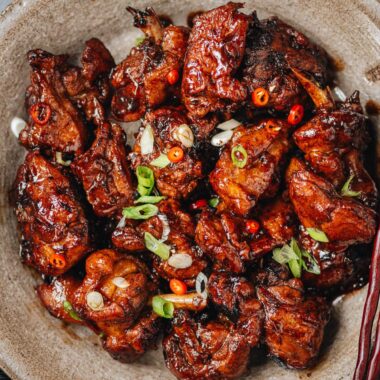
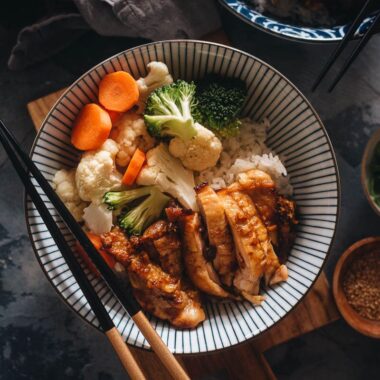
A. Kinder
In step 10 would you clarify what you meant by rotate? I’m guessing you don’t mean flip the pork over?
Maggie Zhu
Not flipping. I added this step so you can place the pork in a different position so avoid uneven heating (the side that faces inside of the air fryer would face outside, after the rotating), because some spots of the air fryer might run hotter. If you skip this step, it won’t cause a huge issue.
Gary Hohenstein
Can you make this without an Air fryer? Oven or deep fryer?
Maggie Zhu
You can definitely make this in an oven. I have an older oven recipe: https://omnivorescookbook.com/siu-yuk/
In that recipe, I roasted at a slightly higher temperature at the beginning. But I think you can roast at 300F for the first 2 1/2 hours. Then roast at higher heat 375F for the last 30 to 40 minutes.
Make sure to use foil to wrap up the pork really tight (my old recipe didn’t include this step). The foil will hold the pork fat and the pork will be protected from overcooking, thus generating a better texture.